Pad kra pao is a Thai holy basil stir fry that I think deserves the title: "National dish of Thailand". It’s a favourite of Thai people and Thai food lovers around the world, and if you're getting into Thai cooking, this has to be on your to-do list. (Not to mention it's super quick and easy!)
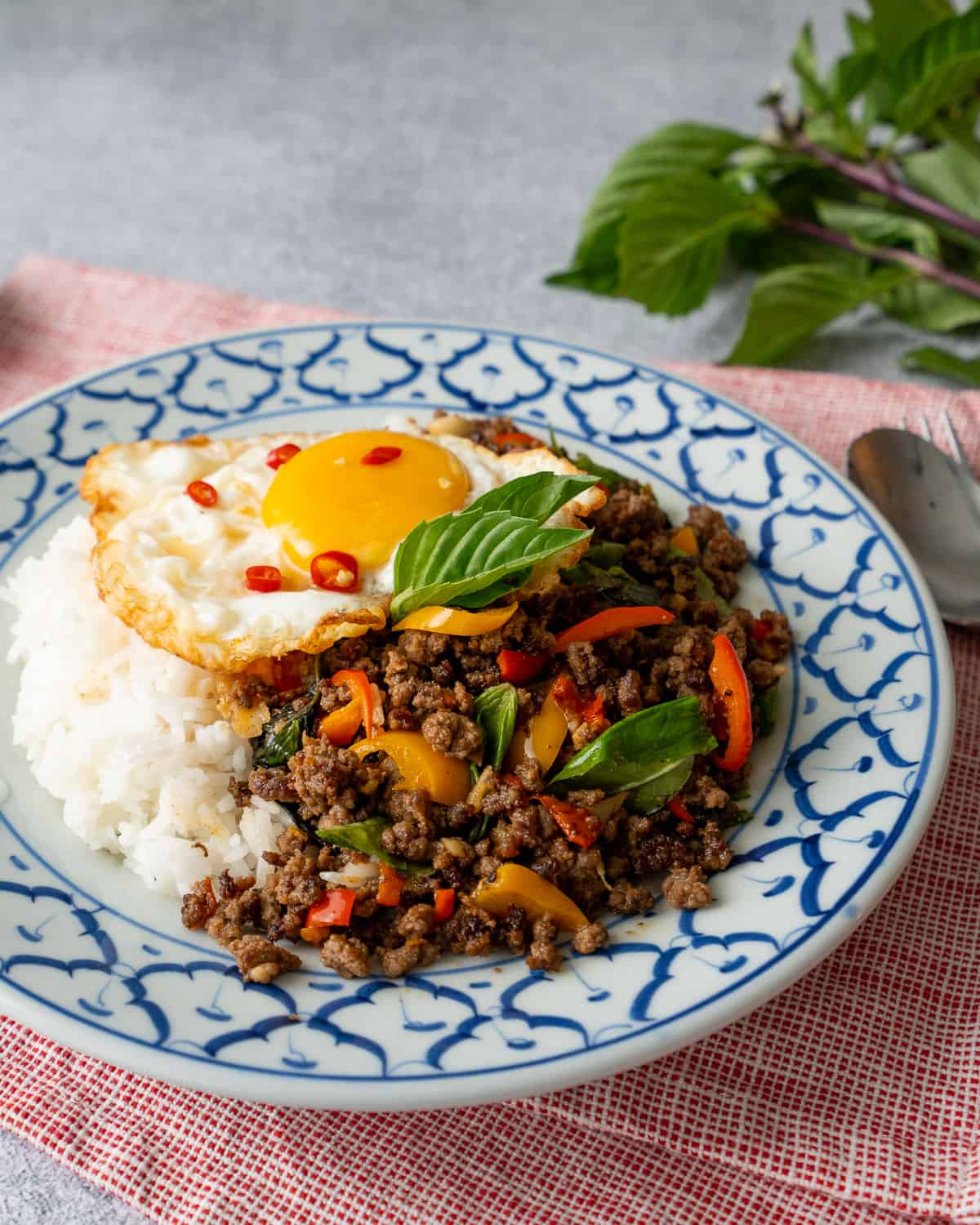
The more modern rendition of pad kra pao (the one your local Thai restaurant probably makes) contains veggies like green beans and onions; along with a more complex seasoning that might include oyster sauce, soy sauce, and dark soy sauce. This recipe, however, is an old-school, traditional style that is much simpler. Many Thais call this the original pad gaprao!
🛎 For the modern pad kra pao see my Thai holy basil chicken recipe.
What is pad kra pao?
Or is it "pad krapow"? Or "pad gaprao"? However you write it (more on that in the FAQ), it's a stir fry of meat (typically ground meat), holy basil, and loads of chilies. It’s served on rice, and usually with a fried egg on top.
In Thailand you can find it cooked to order from a street food vendor, served in a fancy restaurant, or provided in a box ready-to-eat from a grocery store. Anywhere you go in Thailand, you’re never far from a pad gaprao. It really IS the food of the people!
Pad kra pao literally means "holy basil stir fry," so the holy basil is the key ingredient here. This recipe uses ground beef, but can be made with any kind of protein. Of all Thai stir fries, this is one of the easiest to make, and a great weeknight recipe as minimal prep is required. And it's gluten free!
Ingredients & Notes
Here are the ingredients you'll need and important notes about them, and as you can see, it's super simple! For amounts, see the full recipe card below.

- Garlic
- Thai chilis, or another spicy chili such as serrano. This is your source of heat, and for a truly authentic pad kra pao, you want to add as many as you can handle!
- Mild red chilis. We want to have a lot of chili flavor here, but not so much as to hurt ourselves, so we can add some milder ones. Anything red and mild will work such as red anaheim, long red pepper, mini bell pepper or even red bell pepper if all else fails.
- Ground beef, regular or lean. Beef flavour goes very well with holy basil, but feel free to substitute with ground pork, ground chicken, or even plant-based meat substitutes.
- Fish sauce. Fish sauce is your only seasoning in traditional pad kra pao, so it’s important to use a good one. Read this post on how to choose a good fish sauce.
- Sugar
- Unsalted beef stock, chicken stock, or water
- Ground black pepper if using beef. For chicken and pork white pepper will also work.
- Holy basil or regular fresh basil leaves. Thai basil will also work, more on substituting holy basil below.
- Eggs, for making fried eggs. Technically optional, but highly recommended.
- Oil for stir frying, I use avocado oil but anything neutrally flavoured is fine.
- Oil for frying eggs, I use canola oil for frying as it's cheaper than avocado oil, but anything neutral and high heat resistant is fine.
- Jasmine rice for serving.
- Prik nam pla (optional) is a spicy fish sauce condiment classically served with pad gaprao. I like to put it on my fried egg to season it, but some people put it on their rice. You just need some fish sauce, chilis, and a squeeze of lime.
TIP: If you've got leftover basil after making this dish, bookmark my all-purpose Thai basil stir fry sauce recipe as a great way to use it up!
How to Make Pad Gaprao
Here's a bird's eye view of the steps. Before you make it, be sure to watch the video tutorial in order to ensure success, especially if this is your first time! If you enjoy it, check out my YouTube channel for more Thai cooking videos!

- In a mortar and pestle, pound the Thai chilies into a fine paste. Add the garlic and the chopped mild chilies and pound just into a rough paste.
- Heat a wok over high heat, then add the beef and spread it out. Sear the beef without moving it until the underside is browned. Toss and keep cooking until liquid from the beef starts to come out.
- Let the beef cook, stirring occasionally, until all liquid has evaporated and the beef starts to sizzle and brown further to develop flavour.
- Push the beef to one side of the pan, add a little more oil and add the garlic and chili mixture, then sauté until garlic starts to turn golden.

- Toss the garlic with the beef then add about half of the stock or water, fish sauce and sugar; toss to mix well.
- Add the julienned mild chilis and toss for 30 seconds; if it’s looking too dry, add a splash more water or stock.
- Turn off the heat, add the basil and mix just until wilted. Taste and adjust seasoning with more sugar or fish sauce as needed.
- To fry eggs with crispy whites an runny yolk. Heat about ¼ inch of frying oil to a small nonstick frying pan over medium-high heat. Once hot, add only the egg white and let it fry until the edges start to turn brown, then using a spoon, push the middle of the white down to make an indent for the yolk to sit in. Break any big bubbles that form in the center. (If you want a firmer yolk, simply fry the whole egg.)

- Once the egg white is browned around the edges, carefully place the yolk into the indentation on top of the white.
- Use a spoon to baste some oil around the edges of the egg yolk to help it stick. Let it cook for a bit longer if you prefer the yolk to be a little bit more set.
- Use a wire skimmer to remove from the pan and allow to drain.
- Spoon pad kra pao over some jasmine rice, and top with the fried egg. You can then drizzle the prik nam pla on top of the egg.
How to Make Prik Nam Pla
Prik nam pla is the classic condiment that is served with many Thai dishes, and is used as a tableside seasoning booster. Pad kra pao is usually served with it because the fried egg can always use some extra seasoning.
You don't need a recipe for prik nam pla, in the same way that you don't need a recipe for a PB & J sandwich, because you can make it to your preference. But here is a guideline to get you started:
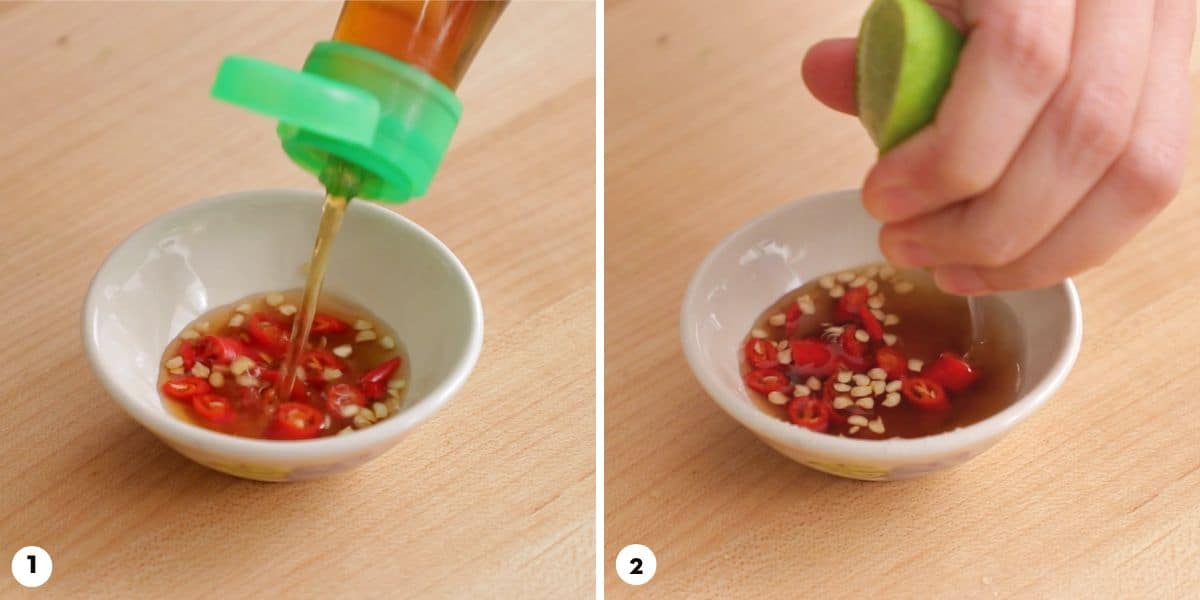
- Combine chopped chilies and fish sauce in a small bowl. You can also add thinly sliced garlic and/or shallots if you want to make a fancier one. You can add as many chilies as you like.
- Add a squeeze of lime for some acidity. The amount is up to your preference (some people don't even add any), but a good start is 1 part lime juice to 3 parts fish sauce.
Holy Basil vs. Thai Basil

Many of us are familiar with Thai basil (called horapa in Thai), the sweet-smelling herb with purple stems that come with your pho. But few have come across holy basil.
Compared to Thai basil, holy basil has a fragrance that is less floral and more peppery; which is why it’s paired with very spicy dishes like pad kra pao or jungle curry. The aroma is always hard to describe, but trust me when I say the two smell quite different.

The fragrance is also milder than Thai basil, and unless it’s freshly picked from a healthy plant, it can be rather faint. This is why even in the rare occasion where I can find fresh holy basil, it’s not always a good purchase.
Note: if you’ve ever had pad kra pao in a Thai restaurant outside of Thailand, they might be actually be using Thai basil because holy basil is unavailable. Unless, of course, you live in a big enough city with enough Thai restaurants to warrant a supplier bringing it in.
The Best Substitute for Holy Basil
While you might be tempted to use Thai basil as a substitute because it's...well...Thai, in my experience, you're better off using regular basil, also known as Italian basil. The flavour of Thai basil is so distinct from holy basil that you will end up with a dish that tastes quite different (though still tasty).

Regular Italian basil, while not the same, is a closer flavour match. And I’m usually perfectly satisfied with it when I have to use it. Having said that, if your goal is to replicate that pad kra pao you love from your takeout place, they might actually be using Thai basil!
Frequently Asked Questions
You may have seen this word written out in different ways because there just isn't a "correct" way to write Thai words using English letters. So really, they're all approximations with various degrees of wrong.
But it gets further complicated by the fact that gaprao is a word that is commonly mispronounced by Thai people, so there are various English spellings of both the correct and the wrong ways!
The correct placement of the R is in the last syllable, so ka-prao and ga-prao are variations of the correct pronunciation. But because many more Thai words start with kra- than ka-, it's common for Thai people to say kra-pao instead out of habit.
The choice of K or G, or -ao or -ow, are all minor issues, but if you ask me, the closest spelling to the Thai pronunciation is gaprao.
So...why did I title this post pad kra pao, you ask? Because that seems to be the most common English spelling, so I've chosen it in order to help you find my recipe when you search for it!
Yes! If using ground chicken, use dark meat rather than breast so it will not be too dry. If using pork, stick with regular or lean, not extra lean. You should also skip the prolonged browning technique that I use with beef here because chicken and pork can become too dry.
Instead of ground beef you can use ground plant-based meat substitute, or use crumbled extra firm tofu and/or chopped mushrooms. Instead of fish sauce, use soy sauce.
Save this recipe!
A Useful Tool for Navigating Beef Cuts
There are so many cuts of beef on the market, and if you've ever wanted to try a new beef cut but not sure what to do with it, check this out. Canada Beef, our sponsor for this post, has launched the Canadian Beef Information Gateway which breaks down over 70 cuts of beef, complete with info on how to best cook them and new recipes you can try out.
Check it out and you'll be amazed! Access the Gateway here or scan the QR code below!

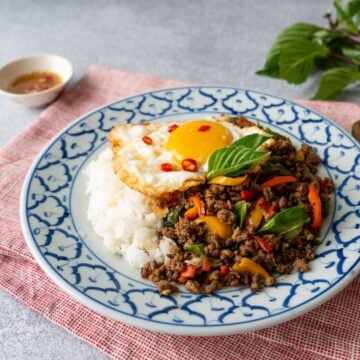
Thai Holy Basil Stir Fry with Beef (Pad Kra Pao)
Save this recipe!
Ingredients
- 6 cloves garlic
- 3 Thai chilies, or as many as you can handle
- ¼ cup chopped mild red chilies, (see note 1)
- ⅓ cup julienned mild red chilies
- 2 tablespoon vegetable oil
- 12 oz ground beef, regular or lean
- 1 tablespoon + 2 teaspoons fish sauce
- 1 tablespoon granulated sugar
- ½ cup unsalted beef or chicken stock or water
- ½ teaspoon ground black pepper
- 1 ¼ cups holy basil or regular basil leaves, (see note 2)
- Cooked Jasmine rice for serving
- 3 eggs, for fried eggs (1 per person)
- Oil for frying eggs, as needed
Prik Nam Pla (optional condiment)
- 1-2 Thai chilies, chopped
- 2 tablespoons fish sauce
- 2 teaspoons lime juice
- 1 clove garlic, thinly sliced or chopped (optional)
Notes
- Mild red chilies are for colour and flavour, while the Thai chilies are for heat. Traditionally we use spur chilies (prik chee fa) for the mild peppers, but red anaheim or mini bell pepper will work. Regular red bell pepper flesh is a little thicker and more watery than ideal, but it will also be fine if that's the only thing you have!
- Italian basil is my preferred substitute if holy basil is unavailable. Thai basil can also be used, and the dish will be just as tasty, but I find that the flavour of regular Italian basil is closer to that of holy basil.
FULL VIDEO TUTORIAL
All my recipes come with step-by-step video tutorials with extra tips not mentioned in the blog post, so make sure you watch the video to ensure success. If you enjoy them, consider subscribing to the YouTube Channel to not miss an episode. Thank you!
Subscribe to my YouTube ChannelInstructions
For the Prik Nam Pla
- Add chopped Thai chilies and garlic into a small bowl, then add the fish sauce and lime juice. Let this sit while you make the stir fry.1-2 Thai chilies, 2 tablespoons fish sauce, 2 teaspoons lime juice, 1 clove garlic
For the Stir Fry
- In a mortar and pestle, pound the Thai chilies into a fine paste. Add the garlic and the chopped mild chilies and pound into just a rough paste.6 cloves garlic, 3 Thai chilies, ¼ cup chopped mild red chilies
- Heat a wok or a large skillet over high heat, adding about 1 tablespoon of the oil if your beef is lean. Once the wok is very hot, add the beef and spread it out. Sear the beef without moving it until the underside is browned. Toss the beef, and notice how the beef will start to release quite a bit of liquid - keep stirring until all of this liquid has evaporated, and the beef starts to sizzle in its own fat. Once the beef is sizzling, allow it to cook without stirring for 15-20 seconds to brown the beef further and develop flavour, then toss, and repeat the browning 1-2 more times.12 oz ground beef, 2 tablespoon vegetable oil
- Turn the heat down to medium, push the beef to one side of the pan, and if there isn’t much fat in the pan, add a little bit more oil just so there’s enough to saute the garlic. Add the garlic and chili paste and sauté in the oil for 30 seconds until aromatic and the garlic starts to turn golden, and then toss it with the beef.
- Turn the heat up to high and add about half of the stock or water, fish sauce, sugar, and black pepper; toss to mix well. Add the julienned mild chilies and toss for 30 seconds; if it’s looking too dry, add more of the stock or water.⅓ cup julienned mild red chilies, 1 tablespoon + 2 teaspoons fish sauce, 1 tablespoon granulated sugar, ½ cup unsalted beef or chicken stock or water, ½ teaspoon ground black pepper
- Turn off the heat, add the basil and mix just until wilted. Taste and adjust the seasoning with more sugar or fish sauce as needed, and add a little more water or stock if it feels too dry. Set this aside while you fry the eggs.1 ¼ cups holy basil or regular basil leaves
For the Crispy Fried Eggs
- To fry the eggs Thai-style, I recommend frying them 1 at a time to prevent them from sticking to each other. There are 2 options for frying eggs:For crispy whites and semi-set yolk: Add about ¼ inch of frying oil to a small nonstick frying pan and put it over medium-high heat. Once the oil is hot, add the egg and allow the egg white to bubble. Use a spoon to occasionally baste the top of the egg with oil to cook the yolk. Once the whites are crispy and browned around the edges and the yolk is set to your liking, you can remove it from the pan.For eggs with crispy whites and runny yolk: Separate the egg white and the egg yolk. Add about ¼ inch of frying oil to a small nonstick frying pan and put it over medium-high heat. Once the oil is hot, add the egg white and let it fry until the edges start to turn brown. Use your spatula to push the middle of the white down to make an indent for the yolk to sit in. Once the egg white is browned around the edges, carefully place the yolk into the indentation, and use a spoon to baste some oil around the edges of the egg yolk to help it stick to the egg white. Remove from the pan and allow to drain.
- To serve, put jasmine rice on a plate, spoon the pad kra pao over half of the rice, and top everything with the fried egg. You can then drizzle the prik nam pla on top of the egg when ready to eat.Cooked Jasmine rice for serving



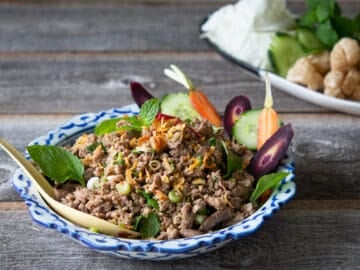
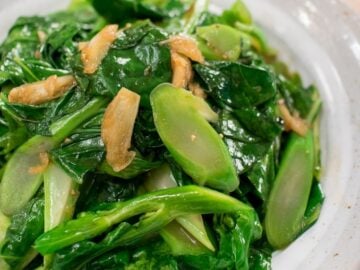





Vicki says
This is such a great recipe for using ground beef. I don't always have basil around but grow a Thai mint that tastes more like basil than mint. Not trying to pass mine off as authentic, but we love it so much I have to double or triple the recipe to make sure there are leftovers for lunch the next day.
C M says
INCREDIBLE honestly! Beyond restaurant worthy.
I struggled a bit with the crispy fried egg (had to sacrifice the first attempt straight to my mouth lol) but this is EXACTLY what I’ve been looking for!
I’ve been fed up paying over the odds
for this dish in the UK that aren’t a patch on all the delicious ones I’ve enjoyed on trips to Thailand.
This is the third recipe of yours I’ve tried and has smashed it out the park yet again. You’re the only site or YouTube channel I come to when I want to make next level authentic Thai food. Thank you!
Chloe S. says
A new favorite - I happened across the fresh Tulsi with a CSA pick-up and now I will try to look for it at farmer's markets! it's so easy to whip together something to eat, that's always been a favorite at Thai restaurants....THANKS for this recipe and will try the other ones on your site.
KTL says
@Hendrick: You're so annoying! And you're annoying me as a reader. Unless you're contributing something useful - which in this case you're def NOT!
Just take well enough as it is. Don't nitpick. It's not socially acceptable.